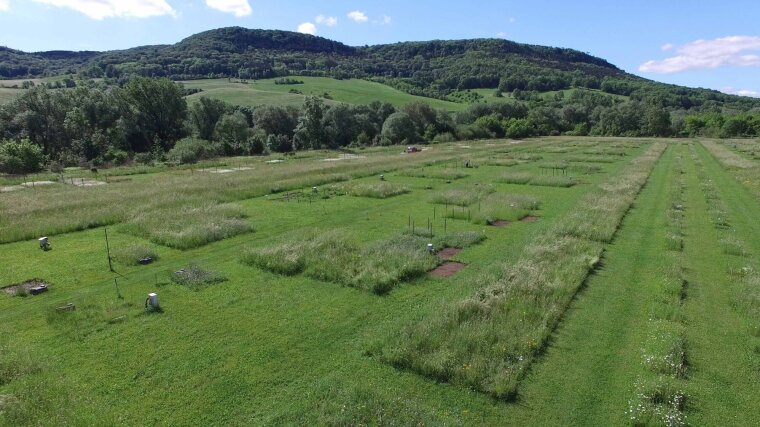
- Life
- Research
Published: | By: Volker Hahn/Kati Kietzmann
The German Research Foundation (DFG) is to fund a Research Unit in the Jena Experiment for a further four years with around five million euros. The scientists, led by the German Centre for Integrative Biodiversity Research (iDiv), Leipzig University and the Friedrich Schiller University Jena, will focus in particular on the stabilising effect of biodiversity against extreme climate events such as drought, heat and frost.
Biodiversity affects how ecosystems function and the services they provide to us. Over the past 20 years, these relationships have been studied in Europe’s largest outdoor biodiversity laboratory, the Jena ExperimentExternal link.
The ten hectares of former farmland on the banks of the river Saale are now home to some 150 experimental plots with different combinations of grassland plants: plots with only one species, with two, four, eight, sixteen or sixty species. This unique, long-term experiment is shedding light on the relationships between biodiversity and ecosystem functioning.
In 2019, the DFG decided to fund a new Research Unit in the Jena Experiment (FOR 5000). After four successful years, this funding is now extended for a further four years, with a total budget of around 5 million euros. The new focus is on the stabilising effect of biodiversity against extreme climate events such as heat, frost or heavy rainfall. A central hypothesis is that species-rich grasslands are more stable than those with fewer species. In this context, stable means that the properties and functions of an ecosystem (e. g. plant biomass, soil temperature or nutrient levels) change little over time.
Biodiversity has a stabilising effect
In some cases, biodiversity has already shown to have a stabilising effect. For example, a large meta-study involving the Jena Experiment showed that the growth of species-rich grasslands is less affected by particularly wet or dry weather than that of species-poor grasslands. The researchers will now investigate this stabilising effect for other important ecosystem functions and aim to gain a better understanding of the underlying mechanisms.
The new phase of the Research Unit is working on a total of twelve sub-projects involving twelve German research institutions. In addition to iDiv and the Universities of Leipzig and Jena, these include the Helmholtz Centre for Environmental Research (UFZ) and the Max Planck Institute for Biogeochemistry in Jena. Moreover, there are international partners from Austria, the Netherlands, the US, China and France.
“Two important processes are taking place at the moment: both the climate and biodiversity are changing rapidly. This is why it is very important to investigate whether, and how, biodiversity can help to stabilise ecosystem functions,” says Professor Nico Eisenhauer, spokesperson for the DFG Research Unit and group head at iDiv and Leipzig University. “The Jena Experiment, with its long-term experiment in the Saale floodplain, offers ideal experimental conditions for this research question. We have been measuring ecosystem processes and environmental changes here for more than 20 years and can now study what makes ecosystems stable. Agriculture and nature conservation will also benefit from our findings.”